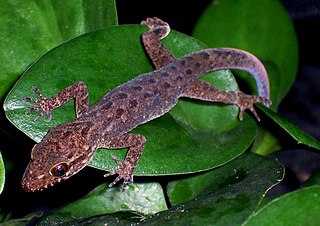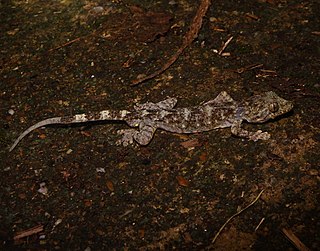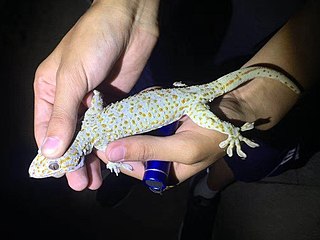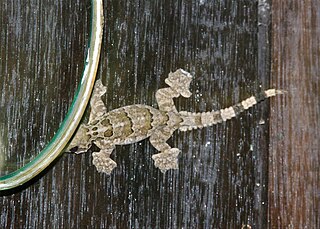
Gekko is a genus of Southeast Asian geckos, commonly known as true geckos or calling geckos, in the family Gekkonidae. Although species such as Gekko gecko are very widespread and common, some species in the same genus have a very small range and are considered rare or endangered.

Cyrtodactylus is a diverse genus of Asian geckos, commonly known as bent-toed geckos, bow-fingered geckos, and forest geckos. The genus has 354 described species as of 2023, which makes it the largest of all gecko genera.

The tokay gecko is a nocturnal arboreal gecko in the genus Gekko, the true geckos. It is native to Asia and some Pacific Islands.

The Oriental leaf-toed gecko, also known commonly as the Asian smooth gecko, Bowring's gecko, Bowring's smooth gecko, and the Sikkimese dark-spotted gecko, is a species of lizard in the family Gekkonidae. The species is native to East Asia.

Gekko smithii, commonly known as Smith's green-eyed gecko or the large forest gecko, is a species of lizard in the family Gekkonidae. The species is native to mainland Southeast Asia and Indonesia.

The Andaman giant gecko, also known commonly as the Andamanese giant gecko, is a species of lizard in the family Gekkonidae. The species is indigenous to the Andaman Islands

Gekko kuhli, commonly known as Kuhl's flying gecko, Kuhl's parachute gecko, or the gliding gecko, is a species of lizard in the family Gekkonidae. The species is found in Southeast Asia.
Canh's gecko is a species of lizard in the family Gekkonidae. The species is endemic to Vietnam.

Grossmann's gecko, also known commonly as the marbled gecko, is a species of lizard in the family Gekkonidae. The species is endemic to Vietnam.

The Peking gecko is a species of lizard in the family Gekkonidae. The species is endemic to China.

Adler's gecko is a species of lizard in the family Gekkonidae. The species is native to southern China and northern Vietnam.
Gekko coi is a species of gecko, a lizard in the family Gekkonidae. The species is endemic to Sibuyan Island in the central Philippines.

Lauhachinda's cave gecko is an endangered species of lizard in the family Gekkonidae. The species is endemic to Thailand.

Reeves's tokay gecko is a species of lizard in the family Gekkonidae. The species is endemic to Asia.
Russell Train's marble gecko is a species of lizard in the family Gekkonidae. The species is endemic to southeastern Vietnam.
Gekko shibatai is a species of gecko, a lizard in the family Gekkonidae. The species is endemic to the Ryukyu Islands.
The Siamese green-eyed gecko is a species of lizard in the family Gekkonidae. The species is endemic to Thailand.
Truong's gecko is a species of lizard in the family Gekkonidae. The species is endemic to Vietnam.
Bonkowski's gecko, also known commonly as kap ke Bonkowski in Laotian, is a species of lizard in the family Gekkonidae. The species is endemic to Laos.

Gekko horsfieldii, also known commonly as Horsfield's flying gecko, Horsfield's gliding gecko, and Horsfield's parachute gecko, is a species of lizard in the family Gekkonidae. The species is endemic to Asia.















